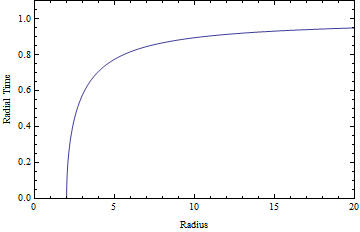I would recommend the book: Edwin R. Taylor and John Archibald Wheeler, Exploring Black Holes: Introduction to General Relativity, 2000, Addison Weslay Longman. Specifically, pages 2-28 to 2-31 discuss gravitational effects on time.
In the following dt[Infinity] is a time interval measured by a stationary clock at infinity. dt[r,M] is the corresponding time interval measured by a clock at a relative radius r to the radius of the black hole horizon. So putting r==2M would correspond to being at the black hole horizon.
dt[r_, M_] := dt[Infinity] Sqrt[1 - 2 M/r]
The following plots the time interval of a clock at radius r relative to the interval measured by a clock at infinity.

The time interval goes to zero at the black hole horizon (r = 2) so you can get values as small as you want. For example, at r = 2.0001 we obtain:
dt[2.0001, 1]
0.00707089 dt[\[Infinity]]
As the clock is moved further and further out its time intervals get closer and closer to the clock at infinity.